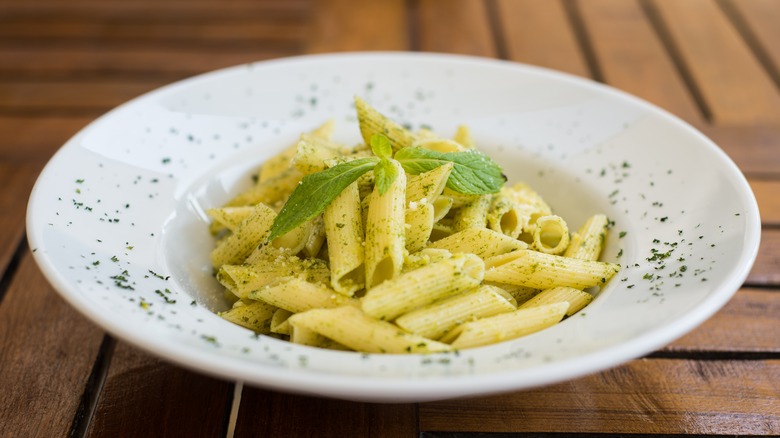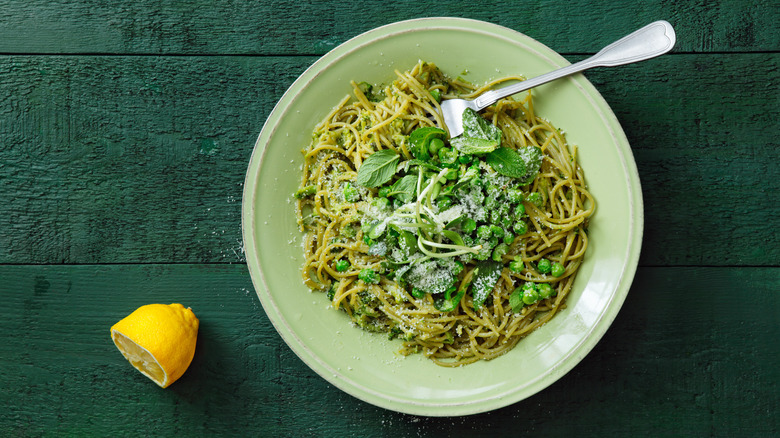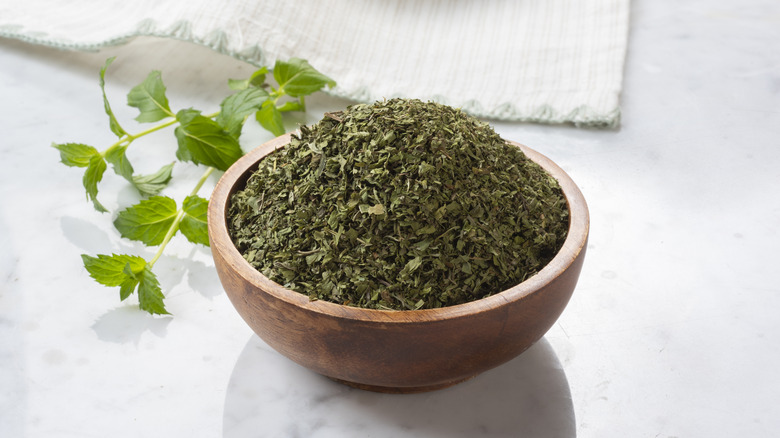Basil Is Out, There's Another Fresh Herb You Need To Try On Pasta
Okay, look. We love basil. We always will. It's a staple of the Italian kitchen for a reason — a delicious, distinctive herb that's equally at home in a pesto alla genovese or a cocktail like a gin basil smash. But there's room, we think, for another herb in your pasta. So this week, ditch your pesto and make your midweek pasta with mint instead. "Wait, mint? That thing in my mojito? Mint, like ... toothpaste?" Okay, it's not that weird. But beyond the classics like lamb with a mint sauce (or a mint julep for the grown-ups) it's far from the most commonly used herb in most American kitchens. But across the globe, and especially in Italy, it's a staple, and we should be using it more.
The mint we're talking about isn't the hyper-concentrated, syrupy stuff we fill our coffees and chocolate bars and chewing gum with. Instead, it's got a fresh, cool but crucially subtle profile, that brings a lift of brightening sweetness to any dish. Across Italy, where mint is incredibly abundant, it's used in everything from panzanella to carciofi alla romana, and pasta. When it comes to the latter, the possibilities are endless. You could try grinding it up into a mint pesto, to toss with some fusilli or penne, or keep things simple, pairing it with some butter and parmesan to really bring out its best in a surprisingly complex and refreshing dish.
More ways to use mint in your pasta
Believe it or not, mint and basil aren't so different. In fact, basil, much like thyme, Greek oregano, and tarragon is part of the wider mint family of herbs. Sweet basil, which is the type commonly used in familiar classics like the aforementioned pesto alla genovese, is even more similar to mint than most of these herbs, with a comparably fresh palate. Mint is slightly less vegetal than basil, though, which makes it a great companion for more delicate pairings like fish. It could work nicely in a spaghetti alle vongole, for example, balancing out the fishiness of the clams and supporting the tomatoes' sugary overtones.
You could take inspiration from the carciofi we mentioned earlier. This Roman style dish pairs mint with the bold flavors of artichoke and anchovy. The former brings earthiness and smoky undertones, while the latter comes in swinging with a salty sucker punch to the palate. Mint pairs gorgeously here, balancing them and ensuring they don't overpower the dish. Simply chop up the artichoke into more manageable chunks and cook it off with the anchovy, garlic, lemon and mint before mixing with bucatini or tonarelli for a Roman-inspired pasta that's to die for.
How to preserve your mint for longer shelf life
If you find yourself with an excess of mint — don't let it go to waste. Fresh mint will last in the fridge for up to three weeks – but during that time it will lose moisture and begin to wilt. Obviously, nobody wants sad, saggy mint, and as it loses that freshness, the flavor will suffer, too. Luckily, there's an easy way to make your mint last!
You can dry it out to preserve that flavor for much longer. In fact, doing this will actually intensify its flavor — as the old adage goes: the less water, the more flavor. You can do it the traditional way, by stringing it up, upside down and out of the sunlight to air-dry for a few weeks. This is the best way to really make sure you're effectively preserving the taste. If you're impatient, though, preheat an oven to 120 degrees Fahrenheit, spread your mint on a tray and leave it in for 20 minutes — turning the oven off after five. Once the leaves begin to curl, they're done.
When using it on your pasta, just be sure to use a little less than you would fresh mint. Because the flavors in dried herbs are more intense, adding too much is going to overpower a dish — just use some trial and error and add a little at a time until the flavor gets where you want it to be.



